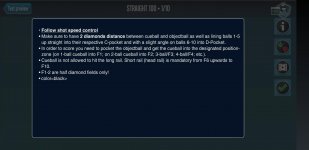Up above I mentioned an exercise for developing the low-speed end of speed control (as many soft shots as possible to make a ball across the table). Here are three more drills to develop such control:
Place ten or so object balls along the head string. Hit the object balls directly with your cue stick as if each one was a cue ball. Hit the first one very softly towards the foot rail. Hit each additional ball so that it goes just beyond the last one you hit. See how many you can do without ever getting to the far cushion. If you do it right you will end up with a diagonal line of balls at the end. Here is a typical result with a failure on the 10 ball:
View attachment 517208
Same line up but this time you have cue ball in hand on each shot and are shooting each object ball an increasing distance.
Finally, place balls anywhere out of the kitchen. For each shot take cue ball in hand behind the line and shoot to just touch one of the object balls. The cue ball must remain within a short distance of the ball you hit (a fist, a hand span, one ball -- you pick it). You can continue until all the balls are on the far rail. This drill is also a good way to find out if the table is level.:smile:
![CropperCapture[285].png CropperCapture[285].png](https://forums.azbilliards.com/data/attachments/381/381530-c7a19758263d054e83d9877957221e14.jpg?hash=x6GXWCY9BU)

